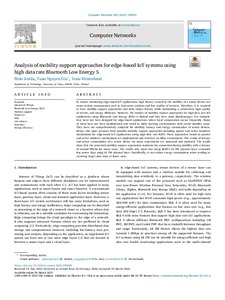Analysis of mobility support approaches for edge-based IoT systems using high data rate Bluetooth Low Energy 5
Westerlund Tomi; Nguyen Gia Tuan; Katila Risto
https://urn.fi/URN:NBN:fi-fe2022081155014
Tiivistelmä
In remote monitoring edge-based IoT applications, high latency caused by the mobility of a sensor device can cause serious consequences such as inaccurate analysis and low quality of services. Therefore, it is required to have mobility support approaches that help reduce latency while maintaining a connection, high quality of service, and energy efficiency. However, the number of mobility support approaches for high data rate IoT applications using Bluetooth Low Energy (BLE) is limited and they have some disadvantages. For example. they have not been designed for edge-based applications where local computation occurs frequently. Many of them have not been implemented and tested in daily working environments with actual mobility cases. They have not comprehensively analyzed the mobility latency and energy consumption of sensor devices. Hence, this paper presents three possible mobility support approaches including passive and active handover mechanisms for edge-based IoT applications using high data rate BLE5. These approaches based on passive and active handover mechanisms are implemented and tested in an office environment. The results of latency and power consumption of a sensor device via many experiments are measured and analyzed. The results show that the presented mobility support approaches maintain the connection during mobility with a latency of around 900ms for many cases. The results also show that using BLE5’s LE 2M physical layer consumes less power than using LE 1M physical layer. Specifically, it can reduce energy consumption when sending or receiving larger data sizes at faster rates.
Kokoelmat
- Rinnakkaistallenteet [19207]
